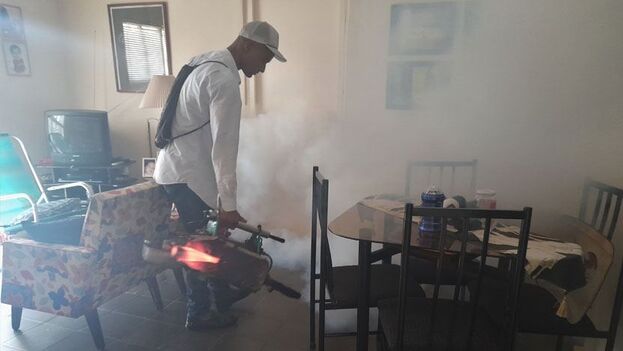
![]() 14ymedio, Havana, 10 November 10, 2022 — With 578 cases of dengue fever identified in the last week, the situation in Ciego de Ávila remains the most critical on the Island. Local statistics, offered in a fragmentary way by authorities, are the only indicator available to gauge the magnitude of the disease in Cuba, a country whose government refuses to disclose the total number of infections.
14ymedio, Havana, 10 November 10, 2022 — With 578 cases of dengue fever identified in the last week, the situation in Ciego de Ávila remains the most critical on the Island. Local statistics, offered in a fragmentary way by authorities, are the only indicator available to gauge the magnitude of the disease in Cuba, a country whose government refuses to disclose the total number of infections.
An extensive report published by the official newspaper Invasor shows pessimism about the possibility of reducing outbreaks and admits that the infestation rate rose to 0.37 percent from 0.05, which the Ministry of Public Health considers “permissible.” All municipalities have cases, but there is a higher incidence in Morón, Ciro Redondo, Baraguá, Majagua and the provincial capital.
Given the health crisis and the terrible conditions in hospitals, Cubans continue to avoid admissions and opt for home treatment, which is complicated by the lack of medicines. In Ciego de Ávila, serotype 2 (DEN-3) is common, which most often turns into hemorrhagic dengue fever, just “when it seems that the symptoms are decreasing.”
In addition, the newspaper says, in the municipalities “it’s common that people won’t open their homes for fumigation or inspection,” and the authorities must “juggle” the few supplies available to execute the endless “campaign against the mosquito.” The most common excuses, they point out, are that the resident “has an asthmatic child,” “is busy” or “is cooking.”
As if that weren’t enough, mosquito nets, essential to prevent being bitten at night, are lacking on the Island, and patients don’t usually respect the rest prescribed for them.
The provincial deputy director of Hygiene, Epidemiology and Microbiology of Ciego de Ávila, José Luis López González, described the fumigation process in the municipalities. First, a “blockade” is made around the residence being diagnosed, consisting of the application of an “adulticide” poison against the Aedes aegypti mosquito in neighboring houses, allowing “the use of the chemical product without oil,” which is also in short supply.
Then, they proceed to fumigate with sprinklers only the house and not the block. Regarding this measure, López González admits that “the population distrusts its scope,” although he assures that “it is effective. Any mosquito that lands, dies.”
The authorities insist that most of the foci are located inside the houses, in containers with water or for animals, and there are a few, like Maricel Ramos, one of the supervisors of the fumigation operation of the Onelio Hernández popular council, in Ciego de Ávila, who believe that the greatest problems come from “garbage cans, vacant lots, wastewater and leaks.”
The article criticizes those Cubans who have decided not to go to hospitals and who, in many cases, don’t show up in the infection statistics. Most of the patients diagnosed as serious, says López González, have already stayed at home several days without going to the doctor.
Invasor recognizes that interruptions in the counting of cases due to lack of laboratory reagents are common, which, “logically,” lowers the rates of infection. In six hours of daily work, the Provincial Microbiology Laboratory can process about 50 samples, but without the necessary conditions and materials, the statistics don’t really reflect the seriousness of the situation. “The numbers, sometimes, don’t tell the whole truth,” says the provincial newspaper.
In Ciego de Ávila the Suma technique (Ultra Micro Analytical System) is implemented, which has allowed analyses to be carried out in the municipalities as well, “without major setbacks other than the ups and downs with the reagents,” explains the newspaper.
The authorities have come to accept home treatment, a “wild card” — as the newspaper calls it — to reserve hospital facilities for the most severe patients, who have vomiting, diarrhea, abdominal pain and bleeding, as well as for children.
To all this, at the meeting of the temporary working group for the control of dengue and covid-19, the Minister of Public Health, José Ángel Portal Miranda, explained with the usual triumphalism that the disease had decreased by 13.2% compared to the previous week.
He didn’t mention Ciego de Ávila, Camagüey and Isla de la Juventud, which reported more cases. Nor at this meeting did the country’s leadership offer the number of infections on the Island, a figure that the Cuban government has treated with the greatest secrecy.
Translated by Regina Anavy
____________
COLLABORATE WITH OUR WORK: The 14ymedio team is committed to practicing serious journalism that reflects Cuba’s reality in all its depth. Thank you for joining us on this long journey. We invite you to continue supporting us by becoming a member of 14ymedio now. Together we can continue transforming journalism in Cuba.
